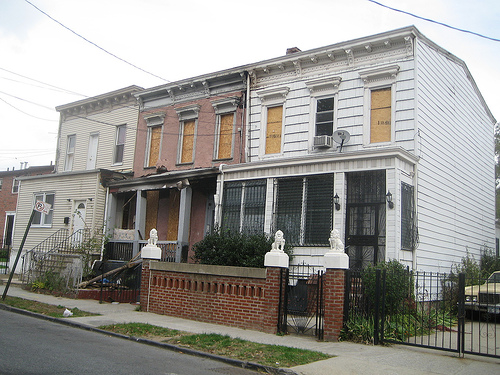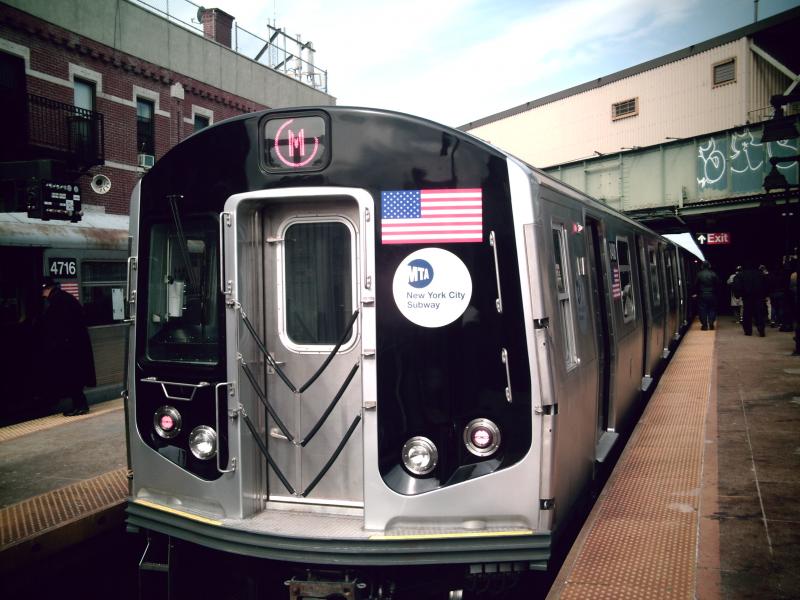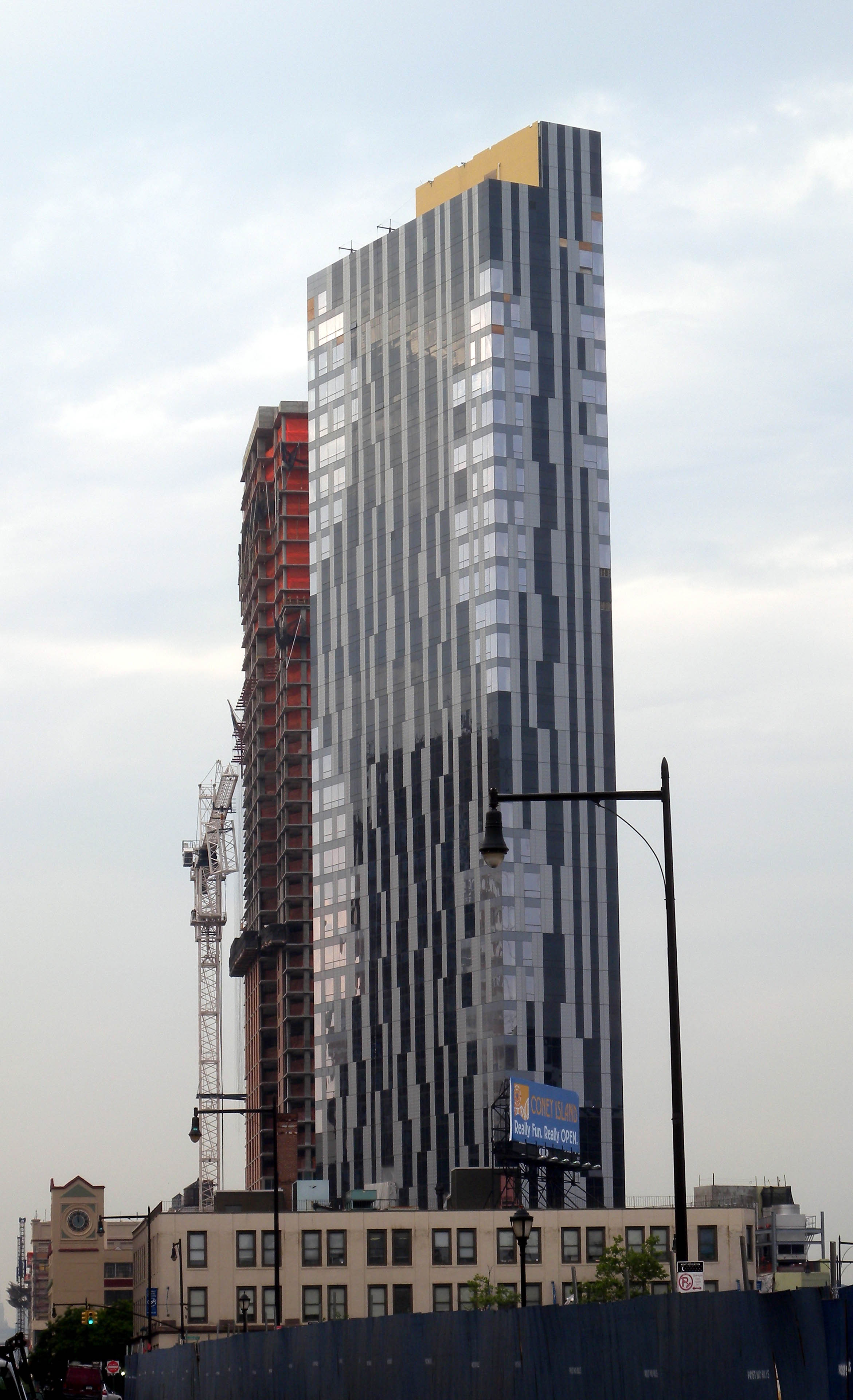|
Myrtle Avenue Elevated
The Myrtle Avenue Line, also called the Myrtle Avenue Elevated, is a fully elevated line of the New York City Subway as part of the BMT division. The line is the last surviving remnant of one of the original Brooklyn elevated railroads. The remnant line operates as a spur branch from the Jamaica Line to Bushwick, Ridgewood, and Middle Village, terminating at its original eastern terminal across the street from Lutheran Cemetery. Until 1969, the line continued west into Downtown Brooklyn and, until 1944, over the Brooklyn Bridge to the Park Row Terminal in Manhattan. Extent and service The following services use part or all of the BMT Myrtle Avenue Line: The Myrtle Avenue Line is served by the service. The line begins at Metropolitan Avenue in Middle Village, Queens. It heads southwest along a private right-of-way, eventually joining an elevated structure above Palmetto Street in Ridgewood and Myrtle Avenue in the Brooklyn neighborhood of Bushwick. Just before reaching B ... [...More Info...] [...Related Items...] OR: [Wikipedia] [Google] [Baidu] |
M (New York City Subway Service)
The M Queens Boulevard/Sixth Avenue Local is a rapid transit service in the B Division (New York City Subway), B Division of the New York City Subway. Its route emblem, or "bullet", is colored since it uses the IND Sixth Avenue Line in Manhattan. The M operates at all times. Weekday rush hour, midday, and early evening service operates between Forest Hills–71st Avenue (IND Queens Boulevard Line), 71st Avenue in Forest Hills, Queens, and Middle Village–Metropolitan Avenue (BMT Myrtle Avenue Line), Metropolitan Avenue in Middle Village, Queens, making local stops along its entire route; weekend daytime and late evening weekday service is cut back from 71st Avenue in Queens to Essex Street in the Lower East Side of Manhattan; late night service short turns at Myrtle Avenue (BMT Jamaica Line), Myrtle Avenue in Brooklyn. The M is the only service that travels through the same borough via two different, unconnected lines. Additionally, the M is the only non-shuttle service that ... [...More Info...] [...Related Items...] OR: [Wikipedia] [Google] [Baidu] |
Park Row Terminal
The Park Row station was a major elevated railway terminal constructed on the Manhattan side of the Brooklyn Bridge, across from New York City Hall and the IRT’s elevated City Hall station. It served as the terminal for BMT services operating over the Brooklyn Bridge Elevated Line from the BMT Fulton Street Line, BMT Myrtle Avenue Line and their feeders. Until the opening of the nearby Williamsburg Bridge to elevated train traffic in 1913, it was the only Manhattan station available for elevated trains from Brooklyn, and the only elevated station in Manhattan to be owned by a company other than the IRT or its predecessors. Early history For the first fifteen years of its existence, it was used exclusively by trains of the New York and Brooklyn Bridge Railway, a cable-hauled line that spanned the length of the bridge between Park Row and another terminal at the Brooklyn end of the bridge. On June 18, 1898, elevated trains of predecessor companies of the BMT began using the ... [...More Info...] [...Related Items...] OR: [Wikipedia] [Google] [Baidu] |
Broadway-Brooklyn Line
The BMT Jamaica Line, also known as the Broadway - Brooklyn Line is an elevated rapid transit line of the B Division of the New York City Subway, in Brooklyn and Queens, New York City, United States. It runs from the Williamsburg Bridge southeast over Broadway to East New York, Brooklyn, and then east over Fulton Street and Jamaica Avenue to Jamaica, Queens. In western Jamaica, the line goes into a tunnel, becoming the lower level of the Archer Avenue lines in central Jamaica. The and trains serve the entire length of the Jamaica Line, and the serves the line west of Myrtle Avenue. The longest elevated line in the system, the Jamaica Line includes the oldest existing elevated structure in the system – the original 1885 line of the Brooklyn Elevated Railroad, the former BMT Lexington Avenue Line between Gates Avenue and Van Siclen Avenue – as well as the newest elevated structure, the 1988 ramp into the Archer Avenue subway. The Brooklyn–Manhattan Transit Corporation ... [...More Info...] [...Related Items...] OR: [Wikipedia] [Google] [Baidu] |
Dual Contracts
The Dual Contracts, also known as the Dual Subway System, were contracts for the construction and/or rehabilitation and operation of rapid transit lines in the City of New York. The contracts were signed on March 19, 1913, by the Interborough Rapid Transit Company and the Brooklyn Rapid Transit Company. As part of the Dual Contracts, the IRT and BRT would build or upgrade several subway lines in New York City, then operate them for 49 years. Most of the lines of the present-day New York City Subway were built or reconstructed under these contracts. The contracts were "dual" in that they were signed between the City and two separate private companies. Both the IRT and BRT (later Brooklyn–Manhattan Transit Corporation, or BMT) worked together to make the construction of the Dual Contracts possible. Background In the late 19th century and for most of the 20th century, New York was host to millions of immigrants each year. Many of the immigrants crowded into tenements and other ap ... [...More Info...] [...Related Items...] OR: [Wikipedia] [Google] [Baidu] |
Steam Dummy
A steam dummy or dummy engine, in the United States and Canada, was a steam locomotive enclosed in a wooden box structure made to resemble a railroad passenger coach. Steam dummies had some popularity in the first decades of railroading in the U.S., from the 1830s but passed from favor after the Civil War. Overview It was thought that the more familiar appearance of a coach presented by a steam dummy, as compared to a conventional steam locomotive, would be less likely to frighten horses when these trains had to operate in city streets. Later it was realized that it was actually the noise and motion of the operating gear of a steam engine that frightened horses, rather than the unfamiliar outlines of a steam engine. Production Baldwin Locomotive Works manufactured steam dummies or steam motors for many American tramways. Baldwin exported to places such as Sydney, Australia - where they were known as ' steam tram motors' - and New Zealand, where two, both built in 1891, surviv ... [...More Info...] [...Related Items...] OR: [Wikipedia] [Google] [Baidu] |
BMT Fifth Avenue Line
The Fifth Avenue Line, also called the Fifth Avenue Elevated or Fifth Avenue–Bay Ridge Line, was an elevated rail line in Brooklyn, New York City, United States. It ran above Hudson Avenue, Flatbush Avenue, Fifth Avenue, 38th Street, and Third Avenue from Downtown Brooklyn south to Bay Ridge. The portion on Third Avenue was called the Third Avenue Elevated to distinguish service from the elevated BMT West End Line; it was separate from the elevated IRT Third Avenue Line in Manhattan and the Bronx. History The Union Elevated Railroad Company, leased by the Brooklyn Elevated Railroad, built the Hudson Avenue Elevated, a branch of the Brooklyn Elevated Railroad's Lexington Avenue Elevated. This line split from the Brooklyn elevated at a junction at Hudson and Park Avenues (where exit 29 of the Brooklyn–Queens Expressway is now located), and traveled south above Hudson Avenue to the Long Island Rail Road's Flatbush Avenue terminal. Trains began operating between Fulton Ferry ... [...More Info...] [...Related Items...] OR: [Wikipedia] [Google] [Baidu] |
East New York
East New York is a residential neighborhood in the eastern section of the borough of Brooklyn in New York City, United States. Its boundaries, starting from the north and moving clockwise, are roughly the Cemetery Belt and the Queens borough line to the north; the Queens borough line to the east; Jamaica Bay to the south, and the Bay Ridge Branch railroad tracks and Van Sinderen Avenue to the west. Linden Boulevard, Pennsylvania Avenue, and Atlantic Avenue are the primary thoroughfares through East New York. East New York was founded as the Town of New Lots in the 1650s. It was annexed as the 26th Ward of the rapidly growing city of Brooklyn in 1886, and became part of New York City in 1898. During the latter part of the twentieth century, East New York came to be predominantly inhabited by African Americans and Latinos. East New York is part of Brooklyn Community District 5, and its primary ZIP Codes are 11207, 11208, and 11239. It is patrolled by the 75th Precinct of the N ... [...More Info...] [...Related Items...] OR: [Wikipedia] [Google] [Baidu] |
Brooklyn Elevated Railroad
The Brooklyn Elevated Railroad was an elevated railroad company in Brooklyn, New York City, United States, operated from 1885 until 1899, when it was merged into the Brooklyn Rapid Transit Company-controlled Brooklyn Union Elevated Railroad. Lines * Lexington Avenue Line, downtown to Cypress Hills * Myrtle Avenue Line, downtown to Ridgewood, Queens * Broadway Line, Williamsburg to Cypress Hills **via incline and Long Island Rail Road Atlantic Avenue Division to Jamaica, Queens; also via New York and Rockaway Beach Railway to Rockaway Park, Queens * Fifth Avenue Line, downtown to Bay Ridge **via incline and Prospect Park and Coney Island Railroad to Coney Island; also via Long Island Rail Road Bay Ridge Branch and Manhattan Beach Division to Manhattan Beach See also *Kings County Elevated Railway The Kings County Elevated Railway Company (KCERy) was a builder and operator of elevated railway lines in Kings County, New York. Kings County is now coextensive with the borough of ... [...More Info...] [...Related Items...] OR: [Wikipedia] [Google] [Baidu] |
Myrtle Av Line Stub Vc
Myrtle may refer to: Plants *Myrtaceae, the myrtle family **''Myrtus'', the myrtle genus * List of plants known as myrtle, including a list of trees and plants known as myrtle In geography Canada * Myrtle, Ontario, a community United States * Myrtle, Kansas, a former settlement * Myrtle, Minnesota, a city * Myrtle, Mississippi, a town * Myrtle, Missouri, an unincorporated community * Myrtle, West Virginia, an unincorporated community * Myrtle Creek (Curry County, Oregon), a stream * Myrtle Creek (South Umpqua River tributary), a stream in Oregon People and fictional characters * Myrtle (given name), including a list of people and fictional characters with the given name or nickname * Chip Myrtle (born 1945), American National Football League player Roads * Myrtle Avenue, New York City * Myrtle Avenue, Hounslow, in the London Borough of Hounslow * Myrtle Road, Sheffield, England, former home ground of The Wednesday Football Club on the street of the same name Other uses * , ... [...More Info...] [...Related Items...] OR: [Wikipedia] [Google] [Baidu] |
Myrtle Avenue Station (BMT Jamaica Line)
The Myrtle Avenue station (announced on New Technology Trains as Myrtle Avenue–Broadway station) is a New York City Subway express station on the BMT Jamaica Line. Located at the intersection of Myrtle Avenue and Broadway in Bedford–Stuyvesant, Brooklyn, it is served by the J and M trains at all times, and by the Z during rush hours in peak direction. The station has two platform levels, but all regular passenger service is on the lower platform level of the station. The station has an abandoned upper platform level which previously served the BMT Myrtle Avenue Line to Downtown Brooklyn and Lower Manhattan via the Brooklyn Bridge. Just east of the station, the remaining section of the BMT Myrtle Avenue Line diverges from the BMT Jamaica Line via slip switches in an at-grade junction. History The lower level of the station opened on June 25, 1888. The upper level station, which was marked on signs as Broadway, opened on April 27, 1889, when the Myrtle Avenue Line was ... [...More Info...] [...Related Items...] OR: [Wikipedia] [Google] [Baidu] |
Myrtle Avenue (BMT Jamaica Line)
The Myrtle Avenue station (announced on New Technology Trains as Myrtle Avenue–Broadway station) is a New York City Subway express station on the BMT Jamaica Line. Located at the intersection of Myrtle Avenue and Broadway in Bedford–Stuyvesant, Brooklyn, Bedford–Stuyvesant, Brooklyn, it is served by the J (New York City Subway service), J and M (New York City Subway service), M trains at all times, and by the Z (New York City Subway service), Z during rush hours in peak direction. The station has two platform levels, but all regular passenger service is on the lower platform level of the station. The station has an abandoned upper platform level which previously served the BMT Myrtle Avenue Line to Downtown Brooklyn and Lower Manhattan via the Brooklyn Bridge. Just east of the station, the remaining section of the BMT Myrtle Avenue Line diverges from the BMT Jamaica Line via slip switches in an at-grade junction. History The lower level of the station opened on June 25, ... [...More Info...] [...Related Items...] OR: [Wikipedia] [Google] [Baidu] |
Myrtle Avenue
Myrtle Avenue is a street that runs from Duffield Street in Downtown Brooklyn to Jamaica Avenue in Richmond Hill, Queens, in New York City, United States. Route description Queens Myrtle Avenue has been a major thoroughfare since the early 19th century, named after the myrtle trees that were plentiful in the area. Most likely, Myrtle Avenue began in Queens and was a plank road that charged a toll. The road eventually hosted the Knickerbocker Stage Coach Line, that ran stagecoach and omnibus services. After World War I, Myrtle Avenue in Glendale was a popular destination for picnickers. With a steam trolley running on the avenue, and its ample adjacent beer gardens and park space, people from as far as Eastern Brooklyn came to Myrtle. In the mid-1920s, the parks closed as a result of Prohibition. Ultimately, the parks became incorporated by the city into what is known today as Forest Park. Currently, Myrtle Avenue is one of the primary shopping strips of Ridgewood, along ... [...More Info...] [...Related Items...] OR: [Wikipedia] [Google] [Baidu] |

.jpg)





